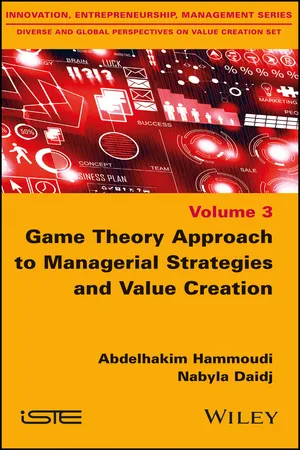
Game Theory Approach to Managerial Strategies and Value Creation
- English
- ePUB (mobile friendly)
- Available on iOS & Android
Game Theory Approach to Managerial Strategies and Value Creation
About this book
Economic players must often choose between several strategic options in a fierce competitive environment where interactions with competitors make decisions particularly complex. Game theory offers useful insights to choose an optimal decision or at least a basis for making rational decision given the constraints of the stakeholders' environment. In presenting the concepts and the logical structure of the reasoning offered by game theory and their applications, the book explains the rational process of decision making in the framework of firm management and market competition. By avoiding the usual complexity of presentation often due to mathematical formalism, the book proposes a reflection and practical insights of game theory for practitioners (managers, strategists) and social, managerial and economic researchers. The book will expose both general teachings and a comprehensive analysis applied to specific case studies of various sectors of the economy.
Frequently asked questions
- Essential is ideal for learners and professionals who enjoy exploring a wide range of subjects. Access the Essential Library with 800,000+ trusted titles and best-sellers across business, personal growth, and the humanities. Includes unlimited reading time and Standard Read Aloud voice.
- Complete: Perfect for advanced learners and researchers needing full, unrestricted access. Unlock 1.4M+ books across hundreds of subjects, including academic and specialized titles. The Complete Plan also includes advanced features like Premium Read Aloud and Research Assistant.
Please note we cannot support devices running on iOS 13 and Android 7 or earlier. Learn more about using the app.
Information
1
Game Theory and Strategic Management
1.1. Game theory and strategic management: semantic and/or conceptual convergences?
“[…] The fundamental notions – game, rules, strategies, etc. – do not refer to the same things in both fields”.
| Authors | Definitions |
|---|---|
| [DRU 54] | “Strategy is analyzing the present situation and changing it if necessary. Incorporated in this is finding out what one’s resources are or what they should be”. [DRU 54, p. 17] |
| [MIN 79] | “Strategy is a mediating force between the organization and its environment: consistent patterns of streams of organizational decisions to deal with the environment”. [MIN 79, p. 25] |
| [LEA 65] | “Strategy is the pattern of objectives, purposes or goals and major policies and plans for achieving these goals, stated in such a way as to define what businesses the firm is in or is to be in and the kind of firm it is or is to be”. [LEA 65, p. 15] |
| [ANS 65] | “Strategy is a rule for making decisions determined by product/market scope, growth vector, competitive advantage, and synergy”. [ANS 65, pp. 118-121] |
| [CHA 62] | “Strategy is the determination of the basic long-term goals and objectives of an enterprise, and the adoption of courses of actions and the allocation of resources necessary to carry out these goals”. [CHA 62, p. 13] |
| [STE 77] | “Strategy is the forging of firm missions, setting objectives for the organization in light of external and internal forces, formulating specific policies and strategies to achieve objectives, and ensuring their proper implementation so that the basic purposes and objectives of the organization will be achieved”. [STE 82, p. 19] |
| [POR 80, POR 85, POR 96] | “Competitive strategy is about being different. It means deliberately choosing a different set of activities to deliver a unique mix of value”. [POR 96, p. 60] Porter’s philosophy evolved over the years, and with it, his definition of strategy. In 1980, his first book defined the conditions for attractiveness in an industry and analyzed the generic strategies that allow a firm to reach its optimal position on the market. In 1985, he defined business strategy as follows: “the search for a favorable competitive position in an industry, the fundamental arena in which competition occurs. Competitive strategy aims to establish a profitable and sustainable position against the forces that determine industry”. [POR 85, p. 42] |
| [RUM 91] | “Strategic management, often called ‘policy’ or nowadays simply ‘strategy’, is about the direction of organizations, and most often, business firms. It includes those subjects which are of primary concern to senior management, or to anyone seeking reasons for the success and failure among organizations. Firms have choices to make if they are to survive. Those which are strategic include: the selection of goals, the choice of products and services to offer; the design and configuration of policies determining how the firm positions itself to compete in product-markets (e.g. competitive strategy); the choice of an appropriate level of scope and diversity; and the design of organization structure, administrative systems and policies used to define and coordinate work”. [RUM 91, pp. 5–6] |
- – firm–environment relation (external diagnosis);
- – resources–competencies (internal diagnosis of the firm);
- – resource allocation
Table of contents
- Cover
- Table of Contents
- Title
- Copyright
- Introduction
- 1 Game Theory and Strategic Management
- 2 From Static Games to Dynamic Approaches
- 3 Coalitions Formation
- 4 Application 1: Dieselgate
- 5 Application 2: Emergence of Food Safety Standards
- 6 Application 3: Petrol Stations
- 7 Application 4: HD-DVD versus Blu-ray
- Conclusion
- Appendices
- Bibliography
- Index
- End User License Agreement